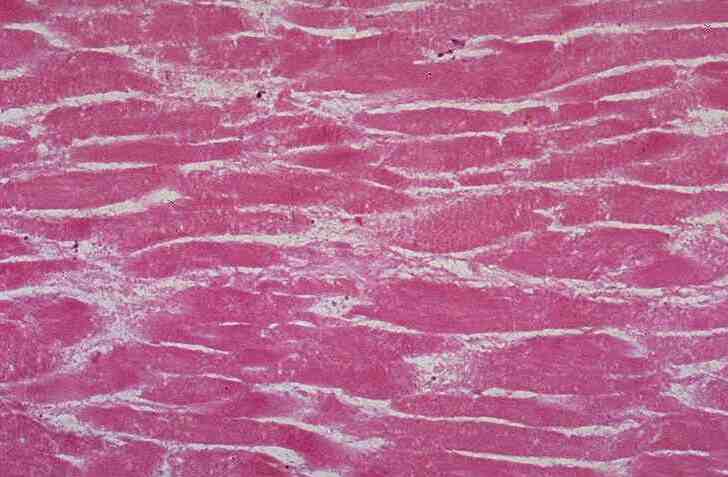
Myocardial Infarct

Click to see other slides: [1] [2] [3] [4]
1.
What is the type of tissue necrosis shown?
Coagulative necrosis
2.
What are the characteristic histopathologic features?
Framework of tissue preserved.
Wavy muscle fibers with elongation, anucleate, homogenous.
Increased eosinophilia of muscle fibers.
Widened spaces between dead fibers contain edema fluid and scattered neutrophils.
3.
How extensive is the pathologic process?
Transmural
infarction (infarction of the full thickness of the ventricular wall)
4. What is the commonest cause of this pattern of necrosis? Name a disease condition in this location.
Irreversible hypoxic injury to the cells leading to denaturation of cytoplasmic proteins, breakdown of cell organelles, and cell swelling.
Myocardial infarction.
5.
What is the corresponding naked eye appearance of this affected region?
Based on the histological specimen given, the infarct should be less than 12
hours and therefore would be inapparent on gross examination. However, if the
tissue slices are immersed in a solution of triphenyltetrazolium chloride, the
affected region will be revealed as an unstained pale zone. By 12 - 24 hours,
the affected region can be identified as a red-blue due due to stagnated,
trapped blood.
6.
In what ways can the function of the heart be affected during this early
period?
Due to ischemia, there will be a loss of contractility resulting in a decrease
in stroke volume.
Arrhythmias.
Contractile
dysfunction.
Papillary
muscle dysfunction.
7. Give some possible outcomes of the above condition.
Left ventricular failure with hypotension, pulmonary vascular congestion, and transudation into the interstitial pulmonary spaces, which may progress to pulmonary edema with respiratory embarrassment.
Arrhythmias: sinus bradycardia or tachycardia, ventricular tachycardia, fibrillation or asystole leading to sudden death.
Myocardial rupture with hemopericardium and cardiac tamponade leading to death.
Formation of a mural thrombus leading to thromboembolism.
Ventricular aneurysm due to gradual
distension of the weakened fibrous part of the left ventricular wall with
thrombus formation, arrhythmias and heart failure.
Chronic
intractable left-heart failure due to inadequate left ventricular pumping action
(common when infarct is extensive and full thickness).
Recurrent MI
Right ventricle infarction
Infarct extension
Infarct expansion
Asystole-systolic stretch
8.
Is this process reversible and why?
It is reversible within the first 30 minutes of the episode.
If ischemia continues, the injury that results is not
reversible because there is permanent loss of function through myocardial cell
death via coagulative necrosis.
Cardiac muscle cells are permanent cells.
The injury heals by fibrosis and scarring.
9. The sequence of events seen microscopically in a myocardial infarct is reflected in the following features:
a.
Cell injury and death
i.
Loss of nuclei (Karyolysis)
ii.
Increased eosinophilia of the cytoplasm
iii.
Loss of myofibrils
b.
Acute inflammation: infiltration of neutrophils
c.
Chronic inflammation: inflammation of lymphocytes
d.
Healing: granular tissue
10.
How old is the infarct shown in the slide?
Is it 6 hrs, 12 hrs, 3 days, 10 days or 3 months?
6
hrs. Because
of absence of fibrous tissues in slide.
<< PREVIOUS INDEX NEXT SLIDE >>
Copyright � Joseph Ong 2003